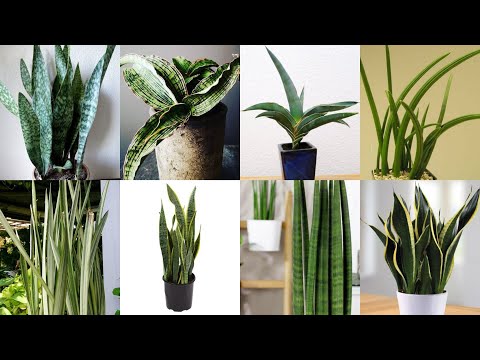Different Types of Snake Plant Care Guide
Kenya Hyacinth Snake Plant
Container: A container with drainage is best. You may choose to put it in a one-gallon or three-gallon container. Kenya Hyacinths prefer to be under-potted.
Soil: It doesn’t matter what type of soil you use for it. Just make sure it’s moist.
USDA Hardiness Zone: 10a to 11b
Temperature/Light: Sansevierias prefer low light exposure. At least 4 hours of sunlight is sufficient for this plant. Do not place plants under intense heat. This prefers temperatures of 65° to 75°F (18° to 24°C).
Water: When watering, do not let the soil become soggy. Never let it stand in water for a long time. Let its soil completely dry before watering again.
Problems/Issues: overwatering leading to root rot.
Other names: Golden Bird’s Nest Sansevieria, Golden Hahnii
Family: Asparagaceae
Subfamily: Crassuloideae
Genus: Sansevieria
Native: Garden Origin and Native to Tropical West Africa from Nigeria to the east of Congo
Golden Bird’s Nest Sansevieria
Container: This type of snake plant requires good drainage, so make sure your container has holes for drainage. You can choose a medium-sized container that is between one and three gallons in size.
Soil: Any slightly acidic or slightly alkaline soil can be used with this sansevieria variety. You can buy soil mixes in the market or make your own.This plant can be grown in regular dirt or in all-purpose fertilizers. Just make sure that you only fertilize once every three weeks during the summer.
USDA Hardiness Zone: 9a to 11b
Temperature/Light: The plant thrives well with partial or full sunshade. Avoid overexposure of more than 16 hours. Its leaves rapidly yellow under excessive exposure to heat and sun. Put it in an average temperature area.
Water: You don’t need to water this snake plant all the time since it is a drought-tolerant type. Allow its soil to dry in between watering. During the winter, the most you should water this is twice a month.
Problems/Issues: This can rot easily if left in water too long. This can be susceptible to aphid attack and mealy bugs.
Other names: Bird’s Nest Sansevieria, Hahn’s Sansevieria, Green Sansevieria
Family: Asparagaceae
Subfamily: Crassuloideae
Genus: Sansevieria
Native: Tropical West African Region
Striped Mother-in-law’s tongue
Container: A container with drainage holes is ideal for this plant. Since it is also best to place this plant indoors, it is best to choose a container that is easy to move.
Soil: A regular soil mix and any potting mix will work well with this plant. You can also use any type of fertilizer. Just make sure you only have this fertilized once every three months during the growing season to avoid overfeeding.
USDA Hardiness Zone: 9a to 11b
Temperature/Light: This plant is tolerant of any light type, even low light. However, it is ideal to expose it to sun for at least 6 hours a day. With regards to temperature, a temperature lower than 50° is already harmful to it.
Water: The Striped Mother-in-Law’s tongue is drought tolerant, which means you won’t need to water it constantly; water it only when it’s already completely dry.
Problems/Issues: The roots of this plant can easily rot when overwatered. It is also prone to mealy bugs and spider mite infestations.
Other names: Sansevieria eillensis
Family: Asparagaceae
Subfamily: Crassuloideae
Genus: Sansevieria
Native: Found in a small region near Eyl in Somalia
Sansevieria masoniana f. variegata
Container: For your container needs, you may choose a medium-sized container that you can easily move around. The container you choose should allow drainage.
Soil: This plant would thrive in regular soil and potting mixes that include pumice and moss.
USDA Hardiness Zone: 11a
Light/Temperature: Place this where there is partial to full sunshade but avoid intense sunlight exposure. It will need at least 6 hours of light. Place it where the temperature is considered average. If the temperature falls below 50° F, place it indoors.
Water: There’s no need to water this plant constantly. Just wait until its soil is completely drier and then water it.
Problems/Issues: overwatering leading to root rot.
Other names: Spear Orchid, Skyline Spear
Family: Asparagaceae
Subfamily: Crassuloideae
Genus: Sansevieria
Native: West Africa
Spear Orchid
Container: Since Sansevieria Cylindrica can be placed indoors from time to time, make sure the container is easy to move. An appropriate 1- to 3-gallon container would do. Just make sure the container has drainage holes.
Soil: This plant is easily grown in any potting mix or with regular soil. The critical thing is that it is well-draining.
USDA Hardiness Zone: 9a to 11b
Light/Temperature: This type of snake plant does not do well in temperatures below 50 °F. Avoid overexposure to intense light.
Water: This should be watered sparingly in winter. It should be watered twice a month on average. Anything other than this should be watered only when the soil is already extremely dry.
Problems/Issues: It is susceptible to root rot if over-watered, and can also become infested with insects such as mealybugs and spider mites.
Other names: Cylindrical Snake Plant, African Spear, Spear Sansevieria, Spear Orchid, Skyline Spear Sansevieria
Family: Asparagaceae
Subfamily: Crassuloideae
Genus: Sansevieria
Native: Angola


